BeiHai Park
June 30th, 2010 No Comments Category: China Destinations Feed for this Entry
BeiHai Park(Chinese: 北海), in central Beijing close to the Forbidden City, is one of the oldest and most authentically preserved imperial gardens in China. BeiHai Park has a history of over 1,000 years. BeiHai Park has existed throughout the Liao, Jin, Yuan, Ming and Qing dynasties.

Introduction of BeiHai Park
BeiHai Park covers a total area of over 68 hectares, half of which is a lake. With many places of interest, BeiHai Park is a favorite place to relax or explore - for both locals and tourists.
BeiHai Park is an excellent living example of the ancient chinese art of landscaped gardens with artificial hills, pavilions, halls, temples and covered corridors blended with trees, hills and the lake in a harmony of man and nature. Indeed, BeiHai Park is like a mini Summer Palace in the heart of Beijing.
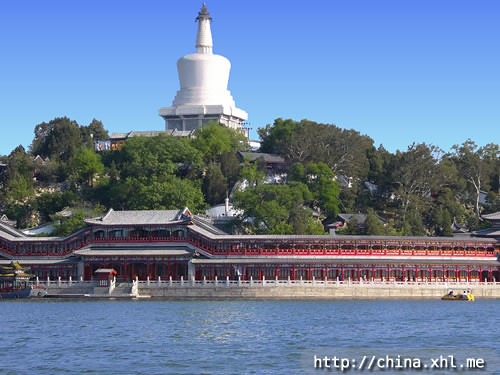
In this guide to BeiHai Park, we will take a tour of all the main sites, accompanied by many beautiful photographs. We also discuss the history of the Park and present a useful map.

History of BeiHai Park
Early in the 10th century, the Liao dynasty created a secondary imperial palace at the site of the present BeiHai Park. The lake was added during the Jin Dynasty. The earth removed to construct the lake was used to create three islands. Two have been joined to nearby land over time but the main one remains in the present Beihai Park.
In the 13th century the Mongols conquered the Jin and established the Yuan Dynasty (1279-1368). The first Yuan emperor, Kublai Khan, expanded the site of Beihai Park and made it the center of DaDu ('Great Capital'), the Yuan capital city (what is now Beijing). Kublai Khan lived in what is now the Round City of Beihai Park.

When the city of Beijing was laid out in its current plan (1406 - 1420 AD) during the reign of Ming Emperor YongLe, Beihai Park was restructured. It continued to function as the imperial family's pleasure garden. The lake was expanded and turned into the centerpiece of this magnificient and classical example of a chinese garden. However, the primary imperial palace - here under the Yuan Dynasty - was from then on to be the newly created Forbidden City.
Most of the buildings now standing in BeiHai Park were constructed during Emperor QianLong's reign (1736-1796) during the Qing Dynasty (1644 - 1911). It was Emperor QianLong who added the Five Dragon Pavilions and the Nine Dragon Screen.

In 1651, the White Dagoba, a Buddhist tower in Tibetan style (and the famous landmark of both Beihai Park and Beijing), was erected at the suggestion of a famous Tibetan Lama priest by the name of NaomuHan. Qing Emperor Shun Zhi agreed to this project as a gesture of devotion to the Buddhist faith - and from a desire for unity among China's various nationalities.
Beihai Park Today
BeiHai Park was first opened to the public in 1925 and in 1961 it was one of the first important cultural sites to be placed under state protection.

The Tibetan style White Dagoba, built in 1651, on Jade (JiongHua) Island is a landmark of both BeiHai Park and Beijing.
 The gardens of BeiHai Park are partly modelled on the style of south China. So, fittingly, south China style paper umbrellas are on sale for protection from the heat of the sun in summer.
The gardens of BeiHai Park are partly modelled on the style of south China. So, fittingly, south China style paper umbrellas are on sale for protection from the heat of the sun in summer.


BeiHai Park is a popular retreat for many local citizens. It is a place to cool down and relax in summer, and in winter it becomes one of the biggest skating rinks in the city.
The south gate of BeiHai Park is just half a kilometer to the west of the north gate of the Forbidden City.




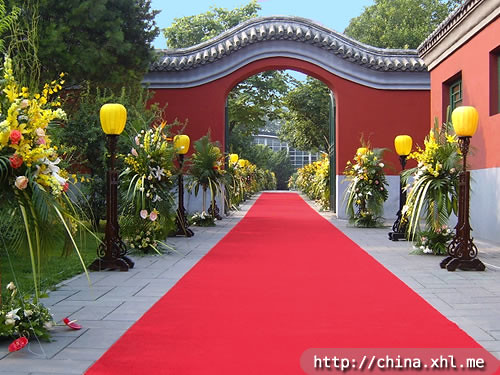
The Qing Dynasty and the White Dagoba

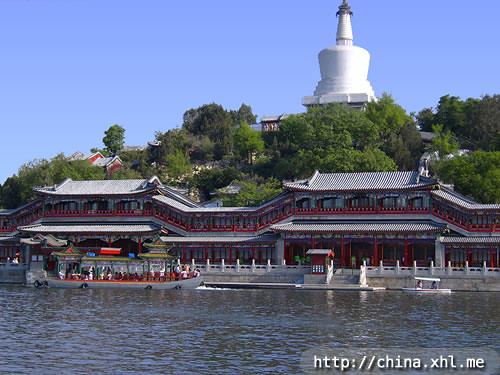
The Circular City(Chinese: 团城)

The Circular City is just inside the main south gate and is the first stop on our suggested route through BeiHai park.
During much of its early history, BeiHai Park has been closely associated with its Circular City. The Circular City (TuanCheng) was at the center of the old Yuan Dynasty city. It was originally on one of three islands on the lake but this island was later joined to the land nearby.
From the outside, it in fact looks like a doll-house sized city surrounded by a high wall that is 276 meters long. The wall surrounds a 4.6 meter high platform that partly overlooks Beihai Lake. On this platform are not only halls and pavilions but also centuries-old pines and cypresses. The Circular City occupies an area of 4,553 square meters.
The main structural attraction is the Hall of Receiving Light (ChengGuangDian) whose architecture is extremely elaborate and unique, even in China. It has a square platform in front and a roof of several tiers of flying eaves. All beams and laths of the hall are splendidly painted, with gilded spirals. The roof is covered with yellow glazed tiles and edged with green glazed tiles.

During the Ming Dynasty, the emperor liked to come here to watch fireworks. It was converted into a Buddhist Hall during the Qing Dynasty.
In a recess at the rear of ChengGuang Hall is a five foot (1.5m) tall statue of a seated Buddha sculpted from a single piece of pure white jade. Some historians claim that this lustrous relic was imported from Burma during the reign of Emperor Guang Xu, possibly a gift from Burmese monks. The crown and garment are made of gold foil inlaid with red and green gems. Its left arm bears gashes made by swords - a result of the looting by soldiers of the Eight-Power Allied Forces who invaded Beijing in 1900.
Another treasure here is an ancient jar carved from a single piece of black / dark green jade. Measuring 160 cm (4.5 feet) in diameter and 70 cm (two feet) high, and weighing 3.5 tonnes, the jar is carved with aquatic designs over its entire surface - dragons, sea horses and fish are pictured leaping and romping in rolling waves. Records say that the jar was made in 1265. It is believed that the Yuan emperor Kublai Khan (Shi Zu) stored wine in it to celebrate victories in war.
When the palace building that housed the jar collapsed, the jar disappeared and somehow fell into the hands of Taoist priests who used it as a pickling jar. Only when Emperor QianLong began his reconstruction of BeiHai Park was the jar located and returned, to be placed in a pavilion at the center of The Circular City, where it stands today.
Two pine trees in The Circular City deserve attention. One was conferred the title of 'Marquis of Shade' by Emperor QianLong for affording him shade in the heat of summer. Formerly in an umbrella shape, the tree lost two of its branches when they were weighed down by heavy snow in 1959. Props have been placed under all remaining branches.
There is also a white-bark pine that towers 25 meters into the sky. Like the 'marquis', it is about eight hundred years old. Emperor QianLong named this tree the 'White Robed General'.

Only small parts of the original Circular City remain today. The plaque tells us of multiple destructive events, the last of which was the invasion by the 8 power european forces in 1900 as a punishment for Chinese assertiveness and emancipation - a reaction to the Boxer Rebellion.
However, the White Buddha that was damaged in that event is still inside the Circular City. Interested visitors can see it on display, together with the ancient dark green jade jar said to have been part of Kublai Khan's court belongings.
Jade Island(Chinese: 琼华岛)

The hill on Jade Island is covered with statues, halls and pavilions, odd-shaped porous rocks, stone steles and tablets, all artistically arranged and landscaped. There are many winding walkways connecting the various sites.

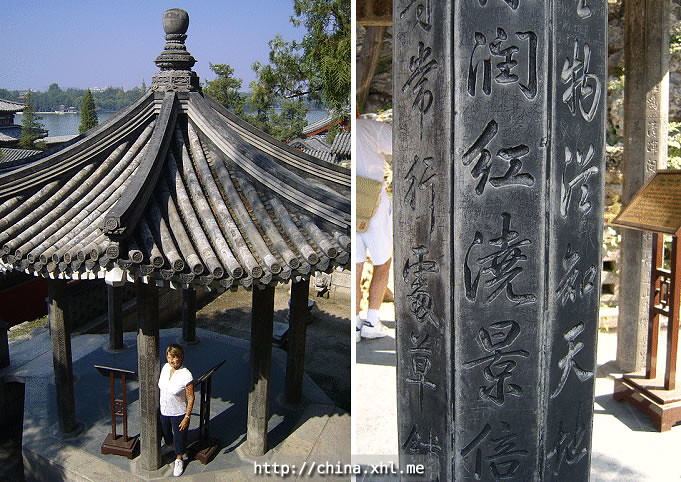
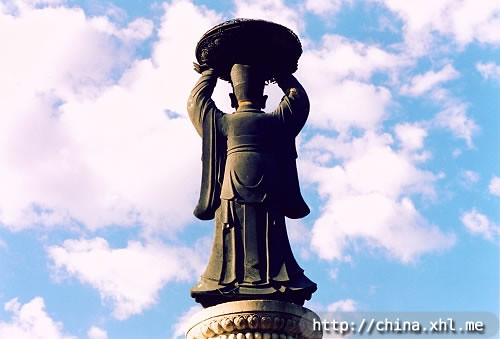

This bronze statue of an immortal stands on the northern slope of the hill, holding a dew plate. It was erected in the 18th century to collect dew for brewing medicine for the royal family.

Still visible on many of the stones are poems and other literary gems carved after the greatly admired handwriting of Emperor Qian Long, whose poetry and calligraphy are well-known for their beauty.
Jade Island is linked with the southern shore of the lake by a stone bridge that is one of the few remaining Yuan dynasty structures.

There is a second stone bridge from the island to the east shore.
YongAn Temple(Chinese: 永安寺)

After crossing YongAn bridge to the island, pass through the colorful gate in front of you and enter Yong'An Lama Temple that delightfully leads up the hill via a number of halls and courtyards until you reach ShanYin Pavillion and the White Dagoba (described below).

YongAn Temple leads up the southern slope of the hill on the same north-south axis as ShanYin Pavilion and the White Dagoba. After the bell and drum towers near the entrance stands FaLun Hall. ShengJue Hall and PuAn Hall form a Tibetan temple further up the hill.

Pavilion of the Benevolent Voice(Chinese: 善因殿)
Past Yong'An Temple at the top of the hill lies ShanYin Pavilion, just in front of the White Dagoba.

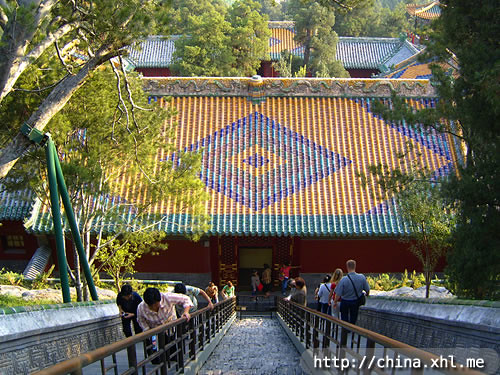
The White Dagoba(Chinese: 白塔)
Sitting on top of the hill on Jade Island, the famous White Dagoba is a 16th century masterpiece of Buddhist art.
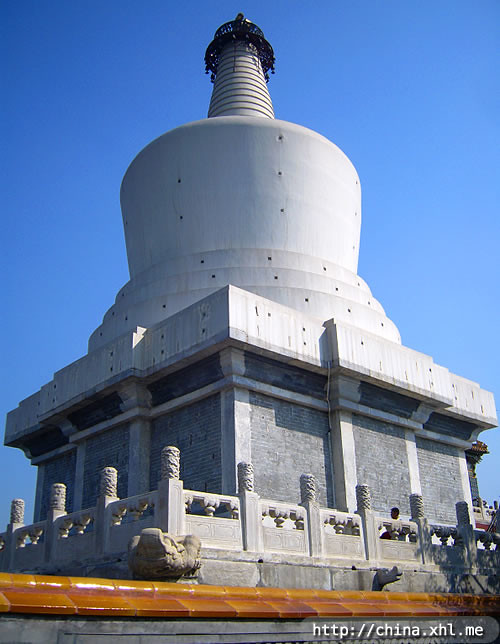
A dagoba differs from the more well-known pagoda in shape. While a pagoda is a multi-storied pyramidic tower, a dagoba is a single rounded structure topped by a spire and crowned by a golden tip - a gilded ball shaped like a flame. Fourteen copper bells hang from its copper canopy.

The White Dagoba in BeiHai Park is 35.9 meters high. It is built of brick and stone whitened with lime. There is no entrance but an intriguing possibility is that a red emblem on the body of the tower is an opening which was sealed when the tower was completed. It is believed that Tibetan Buddhist scriptures, Lama robes and other sacred articles are stored inside. Sutras in the Tibetan language are carved inside the front gate.
The tower offers magnificent views over the city. Visitors can see from here the Five Dragon Pavilions standing on the opposite bank of the lake, with colourful ferry boats travelling back and forth between the shores. Directly south is the quiet (no public access) ZhongNanHai (Central and South Lakes) - two adjacent lakes which are now part of the grounds housing the headquarters of the Chinese Communist Party Gentral Committee and the State Council.
To the south east one can see the yellow roofs and vermilion-walled buildings of the Forbidden City. Clearly visible directly north of the Forbidden City are the five pavilions arrayed along the top of JingShan Hill, which served as a screen for the Palace.
The Long Corridor(Chinese: 游廊)
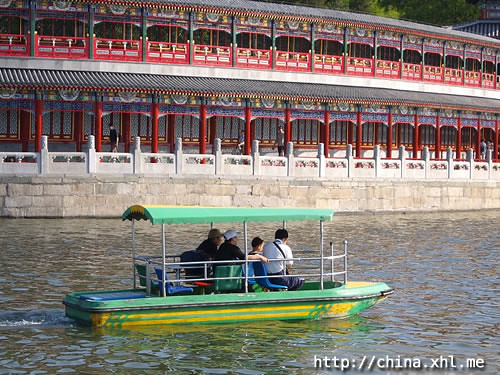



This 300-meter long, colorfully painted walkway is remarkable for having an upper deck. Midway along this corridor are Rippling Water Hall, Tranquility Study and the FangShan restaurant.
At each end of the Long Corridor is a stone gateway.


FangShan Restaurant(Chinese: 仿膳餐厅)

The Fangshan Rcstaurant is an imperial court cuisine restaurant housed in an antique building. It boasts to offer the best imperial court dishes in the city - dishes and pastries based on recipes from the Qing imperial kitchens.
BeiHai Park has a number of other places to eat or drink tea too.

Chamber for Reading the Classics(Chinese: 阅古楼)
After exploring the Long Corridor part of the island, return to the south side by taking the west route. This will take you to the Chamber for Reading the Classics.
This is an open-roofed, fan-shaped hall holding a collection of 495 steles bearing inscriptions by famous Chinese calligraphers since the third century. It will claim the attention of calligraphy lovers for hours.
ZhiZhu Hall(Chinese: 智珠殿)

This hall is located on the eastern side of Qiong Islet with zigzagging paths and ancient trees. ZhiZhu Dian ('Bright Pearl Hall') can be found by climbing the stairs up the hill (the ones on the right) that you will see when near the east bridge. You only need to go up about 1/3 of the way. The hall sits on a tall 'half-moon' semicircular base of bricks. Take the stairway on the righthand side. At the bottom of the stairs, facing the eastern bridge to Qiong Islet, stands a large colorful gate.

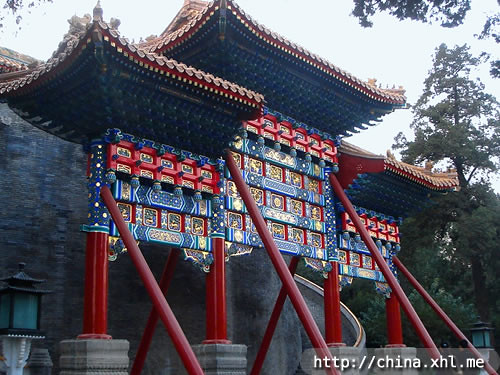
Eastern Scenic Area(Chinese: 东岸景区)

HaoPuJian(Chinese: 濠濮间)


At the north end of the eastern scenic area - just before you reach the north gate - is HaoPuJian. This is a 'garden within a garden'. Hao and Pu were the names of two rivers in ancient China.
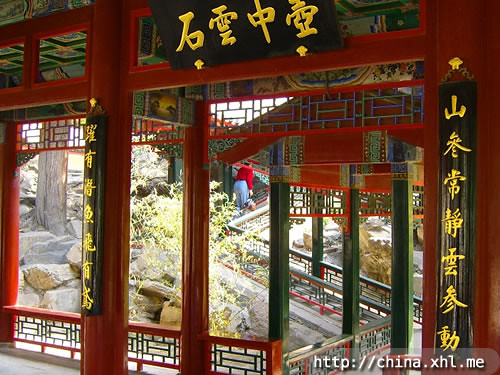
The great philosopher Zhuang Zi stood by the Hao River and said to HuiShi, "Fish jump out and they are very happy." HuiShi replied, "You are not a fish - how do you know the fish are happy?" Zhuang Zi responded : "You are not me. How do you know I do not know the fish are happy?" This garden was built in memory of Zhuang Zi's remarks.

Created in 1757, the 22nd year of Emperor QianLong's reign (Qing Dynasty), HaoPuJian (Carefree Garden) is designed for tranquility, relaxation and admiring nature.
It is enclosed on three sides by small, tree-covered hills.
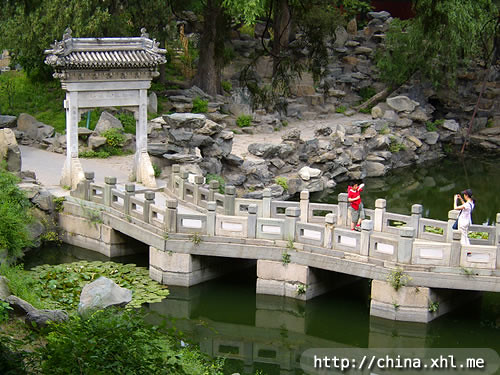
Other structures include the Palace Gate (Gong Men), Room for Viewing Clouds (Yun Xiu Shi) and Room for Admiring Flowers.
There are three waterside pavillions, zigzagging bridges and covered walkways winding around the hills and ponds.
With its serenity and ever-changing scenes as one wanders, HaoPuJian is famed as a 'garden within a garden'.

During the Qing Dynasty the emperor and his wives often came here to watch fish and Emperor QianLong here gave banquets to high court officials.
After, continue north towards the North Gate.When you nearly reach the North Gate, turn west to the north-west scenic area where there are many places of interest.
The Peaceful Heart Garden(Chinese: 静心斋)

Originally built during the Ming Dynasty, it was enlarged in 1759 and again in 1885. It is also known as the 'Minor Garden of Emperor Qian Long'. It covers an area of 8,700 square metres.
JingXinZhai is a classical design combining the private garden style of the south and the imperial garden style of the north.
Lotus and water-lilly ponds, covered walkways, rock gardens, hills and tunnels, stone bridges, galleries and pavilions fill this beautiful area.

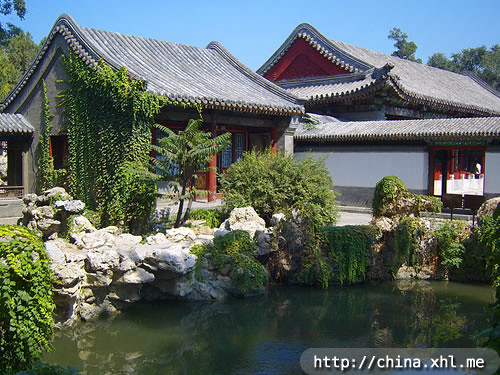

There is also a charming tea house set in a pavillion over the water.



It is easy to miss the entrance to this area; it is flanked by two shops opposite a small-boat harbour.
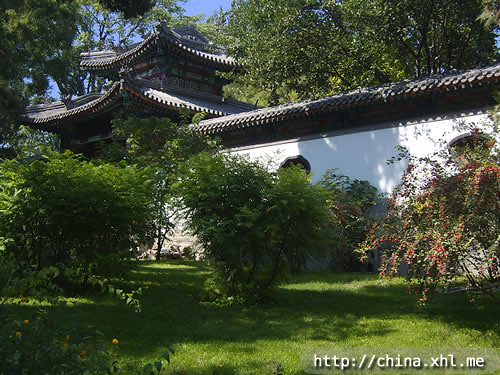
Heavenly King Temple(Chinese: 天王殿)
First built in the Ming Dynasty, Heavenly King Hall was originally the place where Buddhist scriptures were translated and printed. The site was expanded in 1759 to become a complete set of temples. The main halls in TianWang are the Bell Tower, Drum Tower, DaCiZhenRu Hall, Glazed-Tile Tower and Heavenly King Hall.
Also known as 'Xi Tian Fan Jing' (Western Paradise Hall), it was a Zen Lama temple during the Ming Dynasty (1368 - 1644).
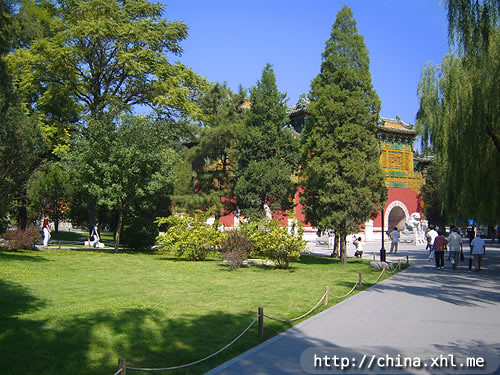


Archway in front of Heavenly King Temple.

Entrance to Heavenly King Temple.
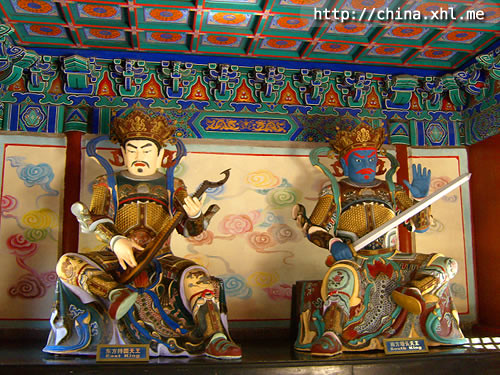
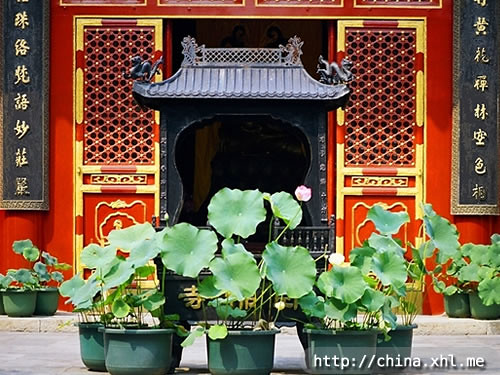
DaCi ZhenRu Hall(Chinese: 大慈真如殿)
DaCi ZhenRu Hall is special in being made entirely from NanMu wood. It has a beautiful unpainted appearance - and the enchanting fragrance from the wood often makes visitors linger. It is one of the finest examples of Ming Dynasty (1368 - 1644) architecture still standing.




The Nine Dragon Screen(Chinese: 九龙壁)

The dragon screen in Beihai Park is one of the three famous screens in China. It was constructed in 1756 during the Qing Dynasty (1644 - 1911).

Uniquely, there are two sides to this glazed-tile screen, which is 5 meters high, 27 meters wide and 1.2 meters thick. The two sides are identical; each has nine dragons sculpted in relief in five colors. It's said that there are 633 dragons in total.

The dragons are depicted frolicking in clouds above the sea. Two centuries of exposure to the elements have failed to alter the colors or lustre of this magnificent work of art.
The digit 9 is the highest value digit and associated with heaven and the emperor. The power of the dragon also symbolises the emperor.
The Five Dragon Pavilions(Chinese: 五龙亭)
These charming pavilions with pointed roof-tops and upswept eaves extend out over the water and are interconnectcd by zig-zagging stone bridges.

The pavilions were constructed during the Ming Dynasty in 1602, the 13th year of Emperor WanLi.

The middle pavillion is the largest and, unlike the others, it has a circular upper roof. It is known as 'Long Ze Ting' (Pavilion of Dragon Benevolence).

In the past, the emperor and his consorts would come here to fish, watch fireworks, or admire the moon over Jade Island.
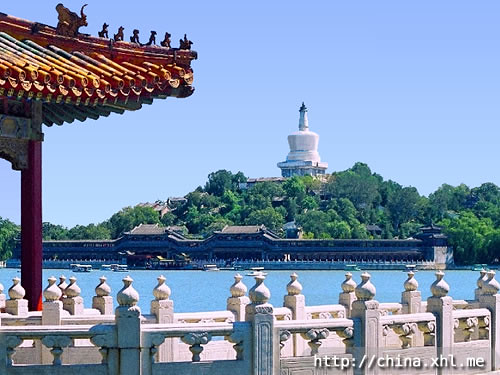
This is a popular spot for locals to play music and sing in many different styles, often with traditional instruments. Sometimes two or three of the pavilions are alive with music simultaneously!

ChanFu Temple and Garden(Chinese: 阐福寺和花园)
This inner garden has many exotic flowers and shrubs of medicinal value. A number of special displays are created throughout the year.
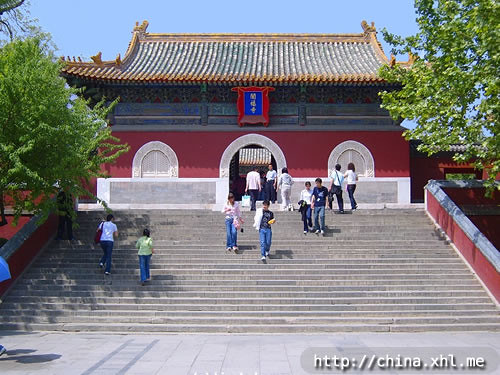
The entrance to ChanFu Temple and the botanical garden.

Part of a large glazed pot near the entrance to the Botanical Garden.


This is where the Ten Thousand Buddhas Tower (WanFoLou) once stood. It was stripped of all the goldfoil Buddha statues when the eight imperialist powers invaded Beijing in 1900. The tower itself in time began to lean and was eventually demolished.
The Temple of Extreme Happiness(Chinese: 极乐世界)
Emperor QianLong built the buddhist GuanYin Hall for his mother - to pray for her happiness and longevity.
The hall and gates occupy an area of 1,260 square meters and the whole is surrounded by water. In each compass direction there is an archway of glazed tiles. It is the largest palatial hall in the style of a square pavilion in China.
Inside the amazingly spacious, high roofed hall is a sculpture of Mount Sumeru. On the hill are statues of GuanYin (a Bodhisattva) and the 800 Arhats. The inscription of 'Extreme Happiness' behind the hill is in the handwriting of Emperor QianLong.

GuanYin Hall, with the southern bridge in the foreground.


Boating on BeiHai Lake(Chinese: 在北海划船)

Now that you have completed our suggested route through BeiHai park, you might decide to hire a small boat and set out on the lake.
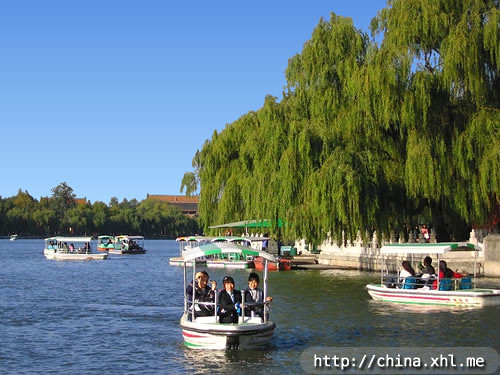
Or take a relaxing ferry boat ride back to Jade Island (near the main south gate). From here you can walk to JingShan park or the Forbidden City. Remember that the Forbidden City closes about 5pm and is very large. JingShan park, however, stays open into the evening (as does BeiHai).

Large boats travel to and from the island to the north west scenic area.
Or perhaps exit from the north gate, cross the road and explore the QianHai area.
Map of BeiHai Park
Beihai Park is composed of TuanCheng (Circular City), JiongHua (Jade) Island, Eastern Shore Scenic Area and Northwestern Shore Scenic Area.
The park occupies an area of 70 Hectares; this incldes a beautiful 39 Hectare lake. The name BeiHai means 'north lake'. The lake itself has the name TaiYe.
Within the garden, pavillions, temples and courtyards nestle amid beautiful scenery of lakes, hills and trees.

QiongHua island is connected to the rest of the park by two stone bridges - one in the south and one in the east. There is also a ferry boat link with the north-west corner of the park. There are also three places to hire a small pleasure boat (indicated by a small blue boat on the map).
To the north of BeiHai is ShiChaHai (QianHai and HouHai) and to its east is JingShan Park. The Palace Museum (Forbidden City) is to the southeast.

Tags: Beijing, BeiHai Park, Park, Jade Island, The Circular City, YongAn Temple
No Comment Yet
Leave a comment